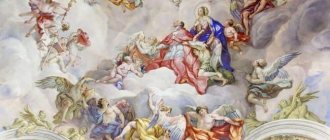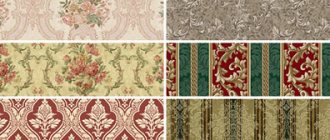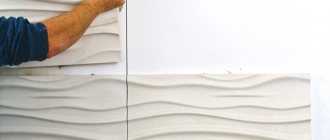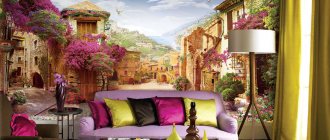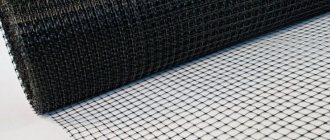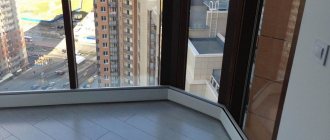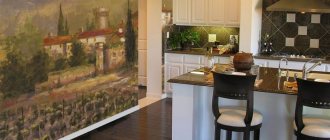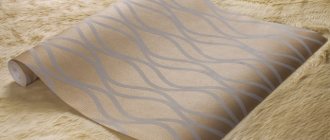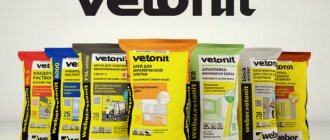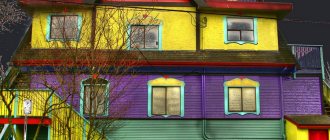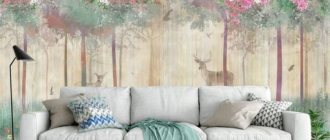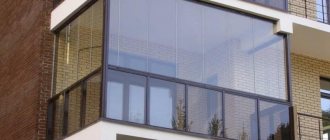What is a fresco?
The word "fresco" is of Italian origin: "fresco" means "fresh". The name for this type of finishing was given by the execution technology. The classic fresco was applied to fresh plaster, which was prepared from a mixture of sand and lime.
Masters prepared paints from natural pigments, added water and applied them to wet plaster. When drying, the two layers literally grew together, which provides the frescoes with amazing durability. Since the plaster dries quickly, it was applied in fragments, immediately creating part of the design with paints. If the master made a mistake, he had to remove the plaster and start again, since it is impossible to correct the drawing . Classical fresco is a very labor-intensive, painstaking work. The first such creations date back to the 2nd century BC. Many frescoes have survived to this day, and they are already several centuries old.
The simpler “a secco” technology involves applying paint to dry plaster. Purely aesthetically, the result is not inferior to classical technology, but in terms of durability it loses a little.
Frescoes have not lost their popularity over the centuries-old history. Moreover, there are ways to very naturally imitate ancient frescoes without spending so much time, effort and money on the traditional method of creation. One of the most popular ways to decorate the interior is to choose mural wallpaper . This decor is inexpensive, there are no special problems with installation, and the choice of designs is huge.
From cracks to rhinestones
The fresco, as a rule, plays the role of the compositional center of the interior. It is no coincidence that every year manufacturing companies present new textures and techniques for working with images, and catalogs of drawings are replenished with fresh works by talented artists. A new product from the Russian fresco manufactory Applico, the “Crystal” series of interior frescoes, combines beauty and durability. A dense mother-of-pearl base with a noble shine and a light texture reminiscent of sand deposits create unusual visual effects due to the reflection of light. Price 1 m² - 7460 rub.
The frescomural “Filigrana” (“Orthograph”) is very original, decorated with rhinestones that emphasize the pattern or individual elements of the image. The number of crystals on one canvas varies from 300 to 1000 or more. The surface looks like a frosty pattern on glass: the texture gives the image lightness and airiness, and the shine of the crystals gives grace. Price 1 m² - from 3900 rub.
Masterpieces of the past come to life on the canvases of Palladio and Antiques (Empir Decor) frescoes. The images reproduce the works of Italian masters of the 18th–19th centuries, not inferior to the originals in size and color, reliably conveying the texture and beauty of ancient frescoes. Price 1 m² - from 2700 rubles.
Velure (Affresco) frescoes with a matte, slightly rough texture have proven themselves to be a durable, resistant material that can withstand exposure to UV rays. They can be washed, and in case of severe damage, restored. Price 1 m² - from 4500 rubles.
Whatever the theme and style, size and design features of the decor, there is no doubt that this picturesque “paraphrase” of medieval frescoes shapes the character of the interior and contributes to the creation of a special atmosphere.
Installation of Affresco frescoes on the ceiling
7 photos
The fresco canvas is rolled out on the floor and the edge from which installation is supposed to begin is marked.
Glue is applied to the back side of the fresco with a paint roller, after which the surface is covered with plastic film, such as a repair film. (For convenient and neat installation, it is advisable to use a film of the same size as the fresco)
Then they wrap the fresco on the tube in which it was packaged, so that the front side of the canvas is inside. The roll should unwind from the marked edge
Apply glue to the ceiling
They unwind about 50 cm of the fresco canvas, removing the film, and apply it to the ceiling. In this case, the tube with the fresco is kept as close to the ceiling as possible
Gradually unwinding the roll, glue the canvas and carefully squeeze out excess glue and air. At the end of the work, trim the edges of the canvases with a sharp knife along a ruler or spatula
The result will be of high quality if the installation is done carefully
What are photo wallpaper murals? How do they differ from ordinary photo wallpapers?
Photo wallpapers are made from paper, vinyl, non-woven fabric and even fabric. In contrast, photo wallpaper-frescoes are produced only on the basis of non-woven material , which is why another name for this finishing option is common - frescoes on a non-woven basis.
Elastic plaster is applied to the interlining, and a pattern is applied on top of it using a special printer for photo wallpaper. The quality of the printing is so high that it is not so easy to immediately distinguish photo wallpaper from a real fresco; the surface usually has a beautiful relief . The finished fresco is treated with special impregnations to better resist moisture and sunlight. The image may become covered with a network of thin cracks , thereby achieving an aging effect.
Photo wallpaper from Picwalls
The widest selection of regular photo wallpapers and digital murals is offered by the Picwalls store. All products are manufactured in-house, so orders of any volume can be completed in a short time. Delivery is carried out in all cities of Russia, and in Moscow and St. Petersburg delivery is free. You can explore the range and buy photo wallpaper for the wall on the page https://picwalls.ru/katalog-fotooboev. If any difficulties arise, the designer from the store will help you choose the appropriate photo wallpaper.
Due to the plaster layer and impregnations, the digital fresco lasts longer than conventional photo wallpaper. In addition, such finishing can hide small defects in the walls. You can buy a ready-made fresco, but if you need a special design or a specific size, you will have to make a digital fresco to order - this is also possible.
Another difference from ordinary photo wallpapers is the price . Despite the fact that this type of fresco imitation costs several times less than traditional technology, compared to photo wallpaper it is still a more expensive finishing option.
The process of installing a digital mural is simple and does not differ much from installing conventional photo wallpaper. Glue for non-woven wallpaper is used. The joints remain invisible, but in an ordinary city apartment it is often possible to do without joints at all, using one solid canvas.
Thanks to special impregnations, frescoes are not afraid of moisture , so they can even be used in bathrooms. Of course, it is better not to install it right next to the bathroom, but the material can easily tolerate constant changes in moisture and temperature.
Conclusion
My instructional article was intended for those who want to make their room attractive and lively. These two conditions can be met with the help of frescoes and photo wallpapers.
Video in this article
will tell you clearly what types of frescoes there are, what their features are and how you can use them in the interior of your apartment.
If you have any questions, ask them in the comments. January 11, 2022
If you want to express gratitude, add a clarification or objection, or ask the author something, add a comment or say thank you!
What to consider when choosing photo wallpaper-fresco?
Since the technology for creating all digital frescoes is the same, when choosing you will have to take into account only the nature of the image, its features and the size of the canvas.
Photo wallpaper murals can be:
- without aging effect , manufactured using the so-called. sand material, a more modern image is obtained, with brighter colors, but with a slight patina of time;
- with an aging effect , on craquelure material, i.e. has a lot of fine cracks. The result is a complete imitation of an ancient fresco and fits perfectly into classic interiors.
As for the nature of the image , you can print anything, but the following topics are in highest demand:
- copies of paintings by famous artists;
- antique scenes;
- panoramic view from the window (sea, medieval city, street)
- columns, arches, famous sculptures and statues;
- portraits of famous historical figures;
- saints, little angels and even icons, religious scenes;
- ornaments and patterns;
- ethnic images;
- nature in all its forms, including landscapes, plants and animals;
- sky, birds and angels - for frescoes that are glued to the ceiling.
Digital murals also successfully imitate airbrushing . Both from afar and upon closer examination, it seems that the drawing was made by an artist.
In general, it is difficult to determine the artificial origin of a digital fresco on a wall due to the texture imitating plaster. The image is applied by a printer, and it would seem that even with the highest image quality, upon closer inspection one could see the raster, but due to the fine sandy texture and cracks, the raster is not noticeable.
The dominant colors in the fresco are chosen for reasons of harmony in the interior. The easiest choice is to take an image whose shades echo the color of the walls, floors, and furniture. You can also take a more complex path - choose an image in contrasting colors to make it an accent detail of the interior.
What to combine with and where to stick photo wallpaper-fresco?
The digital mural is designed for installation on walls and ceilings.
The ceiling surface is rarely completely decorated with a fresco - usually only the central part is decorated. As for the walls, one wall in the room can be entirely decorated with a fresco. You can paste the image only on part of the wall. The digital fresco looks great in niches and framed by columns. As for combination with other materials , there is a wide choice. First of all, let's note the decorative plaster. The history of frescoes began with plaster, so it is not surprising that such images look best on a plastered surface.
The fresco also looks great next to a painted surface and is combined with decorative stone and brick. You can combine fresco photo wallpaper with wallpaper, but it is better if it is a single-color canvas.
A digital fresco is a fairly bright interior detail, so try to keep the rest of the finishing materials calmer, without patterns or designs.
New on the market
Not long ago, a new wallpaper-fresco product entered the market. These products belong to elite finishing materials. This material has become an excellent alternative for wall decoration.
Modern collections of wallpaper frescoes consist of materials such as:
- pressed fibers,
- vinyl,
- polyurethane, etc.
The difference between fresco and photo wallpaper is obvious; the choice of one or another raw material will depend on the taste and financial capabilities of the buyer. If you are a fairly wealthy person, then as an alternative, you should look at the mural wallpaper. They are able to perfectly convey the effects of a variety of painting methods. The peculiarity of the new wallpaper is that it allows for seamless combination of fabrics. Thus, the manufacturers of these products managed to increase the decorative and functional qualities of this wall material.
It is no coincidence that frescoes and photo wallpapers arouse increased interest. It is these decorative elements that can enliven and diversify the interior. The sizes of both are quite impressive, which enhances the impression created. But the effect produced is different in each case. So, what is the difference between a fresco and photo wallpaper?
Digital mural and interior styling
At first glance, it may seem that the fresco is firmly connected with the classical style, baroque and empire, since it became widespread precisely at the time when these styles originated and developed. Nevertheless, fresco wallpaper will look great in a modern interior, you just need to take into account some nuances when choosing the nature of the image and its shades:
- Frescoes with an abstract or very simple design and a small number of colors will fit perfectly into minimalism No angels, ancient scenes or landscapes;
- classical style, baroque, empire, gothic - freedom for using frescoes. Reproductions of paintings, religious motifs, still lifes, and nature are excellent;
- Frescoes depicting lavender fields, grapes, typical French streets, and Paris will fit Provence style
- in the oriental style, images of temples, animals and plants look great;
- into high-tech and loft , but if you really want to, then for high-tech choose a very laconic and preferably monochrome image. Tunnels, bridges, abstraction will do. For a loft, the only option is graffiti.
Mural mural and type of room
Since the digital fresco is resistant to moisture and sunlight, it can be used in any part of the apartment:
- in the living room, the fresco will become a semantic center and set the mood. Choose any image, focusing on your taste and interior style. A reproduction of a painting, a landscape, a still life, an image with perspective - anything will do. It’s great if you can select an entire wall;
- in the kitchen , the fresco will look best in the dining area. Pay attention to still lifes, landscapes, floral arrangements and, of course, traditional antique themes;
- in the bedroom the fresco is usually placed at the head of the bed. Pay attention to images in pastel colors; landscapes, flowers, paintings with lovers look good;
- in a nursery , since a digital fresco can withstand decent mechanical stress. The most appropriate are images of animals and fairy-tale motifs;
- For the hallway, frescoes with perspective are usually chosen in order to “push” the walls of a small room a little.
Various types of images
Images on photo wallpapers and frescoes can be different, each of them has a special effect on the volume and area of the room in which they are located.
Eg:
- Single
is an image of a single structure, plant or animal. If it is located horizontally, then it can visually expand the room, if vertically, it will visually raise the ceilings. - Group
is an image of many buildings, plants or people. It, like a single one, changes the area of the room depending on the geometric features of the location of the pattern, but can be both horizontal and vertical. - An overhead view
is a panoramic view, as if you were looking at something from above. For example: a view from a mountain to a beautiful waterfall (see). This image visually expands the space of the room and is good for use in small rooms. - Bottom view
is an image as if you are looking at the picture from the bottom up. For example: a bottom view of high-rise buildings in a metropolis. Such images should only be used in large rooms, as it reduces the volume of the room. - Enlarged
is an image where an object or plant is greatly enlarged, so that the smallest details are visible. For example: a close-up image of a mask, where all the smallest details and elements are visible. It can make a room smaller. - Distant
is an image of a city or object in the distance. For example: an image of a family of royal lions in the distance, in a green shroud. Such an image can visually expand the area and volume of the room.
Advice! Carefully select the type of image, since an image that makes the room smaller will create discomfort in a small room.
What are the types of images?
The types of images also affect the visual change in the space and volume of the room; such images come on canvases of various sizes and can perform various functions in the interior and design of the room.
They are:
- Realistic. These photo wallpapers come in different sizes. Their three-dimensional image creates a feeling of real volume and reality of the picture.
- Background. Such photo wallpapers are produced in the form of standard rolls. Their image does not require precise joining of the edges, since they usually depict abstraction or geometry.
- Singles. Such images are small in size with a variety of subject drawings. They are usually used to decorate the interior, framed with picture frames or slats in the form of a window.
- Panoramic. Such photo wallpapers are produced on a large canvas of several tens of meters. They cover the entire wall, but some sizes make it possible to cover adjacent walls as well.
Images in the rooms
Each room has its own preferred image themes and colors, for example:
- Any images and colors are suitable for the living room, depending on the style and colors of the interior.
- For the bedroom, calm, preferably natural (see), subjects in light and warm colors are preferred.
- For the kitchen, it is better to choose brighter and more saturated colors and shades, as they increase appetite and mood.
- Calm image subjects in calm shades are suitable for the office so as not to distract from the work process.
- Colorful images with scenes that your child likes are suitable for a nursery. For example, from fairy tales or cartoons, castles (see).
- For the hallway you need light colors of panoramic images, since this is often a small and dark room.
But it all depends on your desires and preferences, as well as on the style and color scheme of the entire room, its area and lighting.
Pasting a digital mural
There is nothing difficult about hanging photo wallpaper-frescoes, but it is better to work with a partner, since it is almost impossible to install a more or less large canvas alone. The gluing process is as follows:
- The digital mural is usually delivered in a special tube. A few hours before gluing, it is better to roll out the material, ideally on a clean floor so that the image is level;
- The wall must be thoroughly cleaned in advance and an acrylic primer applied. The wall must be smooth, but small defects are still acceptable;
- It’s better to make markings on the wall right away; it’s easier to make markings along it. If you have a solid canvas, then mark all the boundaries. If the image consists of several fragments, it is better to measure each strip and make marks on the wall where each of them will begin and end;
- Before gluing, close doors and windows, eliminating drafts;
- take glue for heavy non-woven wallpaper, apply a thin layer of it both to the wall and to the photo wallpaper;
- The fresco must be glued within 3-5 minutes. The image or its fragment is carefully applied to the wall, checking the markings. Using a soft roller or cloth, smooth the image from top to bottom, getting rid of air bubbles;
- if the image consists of several fragments, they are glued end to end.
Maintaining a digital mural is easy. The material can withstand even wet cleaning.
The article was written for the site.
Tags:Apartment design, Wallpaper
